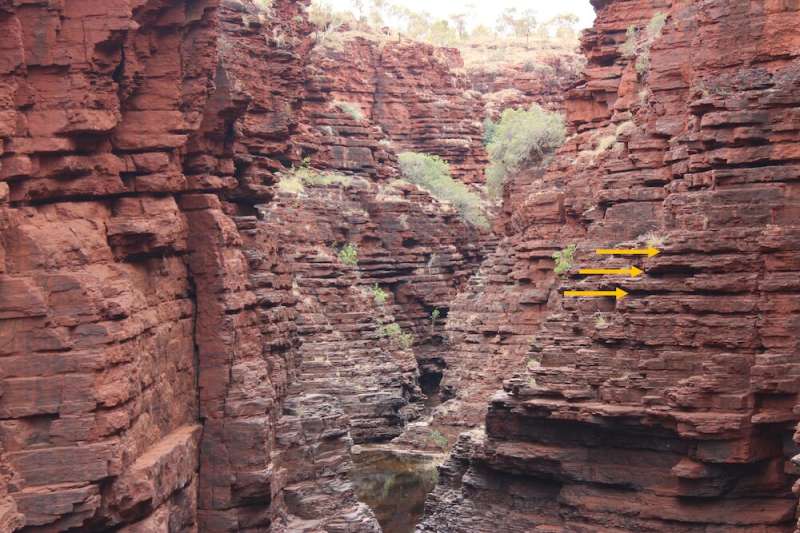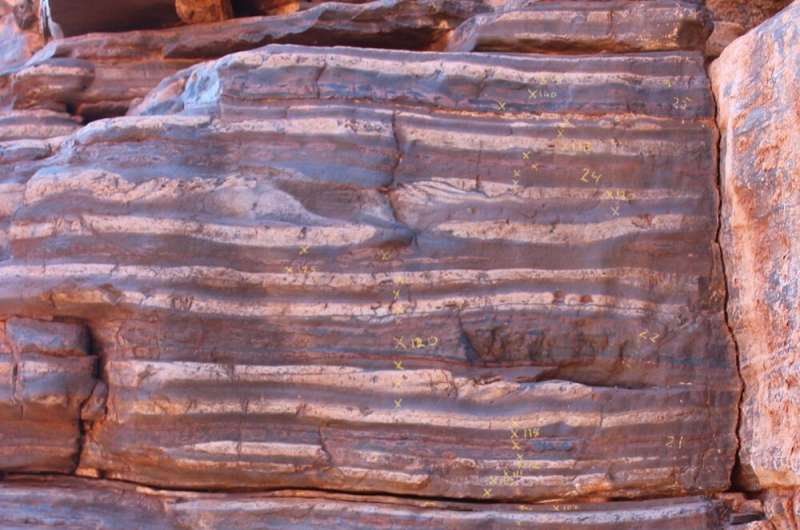Our moon has been slowly drifting away from Earth over the past 2.5 billion years

Looking up at the moon in the night sky, you would never imagine that it is slowly moving away from Earth. But we know otherwise. In 1969, NASA's Apollo missions installed reflective panels on the moon. These have shown that the moon is .
If we take the moon's current rate of recession and project it back in time, we end up with a . However, the moon was formed , meaning that the current recession rate is a poor guide for the past.
Along with our fellow researchers from and the , we have been using a combination of techniques to try and gain information on our solar system's distant past.
We recently discovered the perfect place to uncover the long-term history of our receding moon. And it's not from studying the moon itself, but from reading signals in ancient layers of rock on Earth. Our latest study appears in the Proceedings of the National Academy of Sciences.
Reading between the layers
In the beautiful in western Australia, some gorges cut through 2.5 billion year old, rhythmically layered sediments. These sediments are banded iron formations, comprising distinctive once widely deposited on the ocean floor and now found on the oldest parts of the Earth's crust.
Cliff exposures at show how layers of reddish-brown iron formation just under a meter thick are alternated, at regular intervals, by darker, thinner horizons.

The darker intervals are composed of a softer type of rock which is more susceptible to erosion. A closer look at the outcrops reveals the presence of an additionally regular, smaller-scale variation. Rock surfaces, which have been polished by seasonal river water running through the gorge, uncover a pattern of alternating white, reddish and blueish-gray layers.
In 1972, Australian geologist A.F. Trendall raised the question about . He suggested that the patterns might be related to past variations in climate induced by the so-called "Milankovitch cycles."
Cyclical climate changes
The Milankovitch cycles over spans of years.
Right now, the dominant Milankovitch cycles change every 400,000 years, 100,000 years, 41,000 years and 21,000 years. These variations exert a strong control on our climate over long time periods.
Key examples of the influence of Milankovitch climate forcing in the past are the occurrence of or , as well as or dryer regional climate conditions.
These climate changes have significantly altered the conditions at Earth's surface, such as . They are the explanation for the and . Milankovitch cycles have also influenced the including our .
And the signatures of these changes can be read through .

Recorded wobbles
The distance between the Earth and the moon is directly related to the frequency of one of the Milankovitch cycles—. This cycle arises from the precessional motion (wobble) or changing orientation of the Earth's spin axis over time. This cycle currently has a duration of ~21,000 years, but this period would have been shorter in the past when the moon was closer to Earth.
This means that if we can first find Milankovitch cycles in old sediments and then find a signal of the Earth's wobble and establish its period, we can estimate the distance between the Earth and the moon at the time the sediments were deposited.
Our previous research showed , thus supporting Trendall's theory.
The banded iron formations in Australia were probably as the South African rocks, around 2.5 billion years ago. However, the cyclic variations in the Australian rocks are better exposed, allowing us to study the variations at much higher resolution.
Our analysis of the Australian banded iron formation showed that the rocks contained multiple scales of cyclical variations which approximately repeat at 10 and 85 cm intervals. On combining these thicknesses with the rate at which the sediments were deposited, we found that these cyclical variations occurred approximately every 11,000 years and 100,000 years.
Therefore, our analysis suggested that the 11,000 cycle observed in the rocks is likely related to the climatic precession cycle, having a much shorter period than the current ~21,000 years. We then used this precession signal to .
We found that the moon was around 60,000 kilometers closer to the Earth then (that distance is about 1.5 times the circumference of Earth). This would make the length of a day much shorter than it is now, at roughly 17 hours rather than the current 24 hours.

Understanding solar system dynamics
Research in astronomy has provided models for , and .
Our study and represents one of the only methods to obtain real data on the evolution of our solar system, and will be crucial for .
It's quite amazing that past solar system dynamics can be determined from small variations in ancient sedimentary rocks. However, one important data point doesn't give us a full understanding of the evolution of the Earth-moon system.
We now need other reliable data and new modeling approaches to trace the evolution of the moon through time. And our research team has already begun the hunt for the next suite of rocks that can help us uncover more clues about the history of the solar system.
More information: Margriet L. Lantink et al, Milankovitch cycles in banded iron formations constrain the Earth–Moon system 2.46 billion years ago, Proceedings of the National Academy of Sciences (2022).
Journal information: Proceedings of the National Academy of Sciences
Provided by The Conversation
This article is republished from under a Creative Commons license. Read the .![]()


















